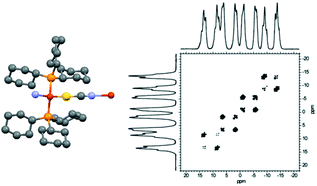Mechanochemical and solution synthesis, X-ray structure and IR and 31P solid state NMR spectroscopic studies of copper(i) thiocyanate adducts with bulky monodentate tertiary phosphine ligands†
Abstract
A number of adducts of

* Corresponding authors
a School of Chemical Sciences, University of Auckland, Auckland 1142, New Zealand
b Department of Physics, University of Warwick, Coventry CV47AL, UK
c School of Chemistry and Biochemistry M310, The University of Western Australia, Crawley, WA 6009, Australia
d School of Science, Griffith University, Nathan 4111, Queensland, Australia
e School of Science and Technology, University of Camerino, S Agostino 1, 62032 Camerino, MC, Italy
f School of Pharmacy, University of Camerino, S Agostino 1, 62032 Camerino, MC, Italy
g Centre for Microscopy, Characterisation and Analysis, The University of Western Australia, Crawley, WA 6009, Australia
A number of adducts of

 Please wait while we load your content...
Something went wrong. Try again?
Please wait while we load your content...
Something went wrong. Try again?
G. A. Bowmaker, J. V. Hanna, R. D. Hart, P. C. Healy, S. P. King, F. Marchetti, C. Pettinari, B. W. Skelton, A. Tabacaru and A. H. White, Dalton Trans., 2012, 41, 7513 DOI: 10.1039/C2DT30579H
To request permission to reproduce material from this article, please go to the Copyright Clearance Center request page.
If you are an author contributing to an RSC publication, you do not need to request permission provided correct acknowledgement is given.
If you are the author of this article, you do not need to request permission to reproduce figures and diagrams provided correct acknowledgement is given. If you want to reproduce the whole article in a third-party publication (excluding your thesis/dissertation for which permission is not required) please go to the Copyright Clearance Center request page.
Read more about how to correctly acknowledge RSC content.
 Fetching data from CrossRef.
Fetching data from CrossRef.
This may take some time to load.
Loading related content
